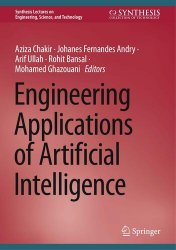Engineering Applications of Artificial Intelligence
- Добавил: literator
- Дата: 26-02-2024, 17:32
- Комментариев: 0
 Название: Engineering Applications of Artificial Intelligence
Название: Engineering Applications of Artificial IntelligenceАвтор: Aziza Chakir, Johanes Fernandes Andry, Arif Ullah, Rohit Bansal
Издательство: Springer
Год: 2024
Страниц: 443
Язык: английский
Формат: pdf (true), epub
Размер: 37.3 MB
Making intelligent devices and systems is the science and engineering of Artificial Intelligence (AI). In order to solve many of the most difficult problems in Computer Science, this important multidisciplinary discipline plays a crucial role in the field of technology nowadays. The book also addresses the topic of Machine Learning because it is closely related to AI. By no means is the list of subjects below intended to be comprehensive. The main objective of this book is to provide researchers, scientists, business professionals, and academics insight into original theories and research findings on the use of human cognitive models in diverse real-world computing applications. Through this book, the authors built an interdisciplinary forum where researchers from many fields may share their work and explore how to engineer human brain processes, learning mechanisms, and decision-making processes.
At the forefront of this technological revolution is the field of Computer Science, where Artificial Intelligence (AI) has emerged as a game-changer. This book emphasizes the paramount importance of AI in Computer Science, shedding light on how it has redefined the way we approach and solve complex problems. From Machine Learning algorithms to natural language processing (NLP), AI has become the cornerstone of modern Computer Science, making tasks more efficient, decisions more informed, and solutions more ingenious.
Artificial Intelligence (AI), an interdisciplinary field combining Computer Science, mathematics, and cognitive psychology, has been rapidly burgeoning with many applications across various industries. The current chapter aims to provide an extensive overview of the theoretical foundations of Artificial Intelligence, "encompassing its definition, characteristics, and subfields, including Machine Learning, natural language processing (NLP), Computer Vision, and robotics". In addition, this chapter delves into diverse intelligence theories, examining how they inform AI research and development. Despite the promising potential, AI faces significant challenges and limitations, such as biases and ethical concerns, that necessitate prompt addressing. Thus, the chapter will cover the managerial challenges in organizations that may adopt AI in the future. This chapter, therefore, underscores the paramount importance of Artificial Intelligence and its potential ramifications for society and organizations, underscoring the need for continuous research in the field of Artificial Intelligence. This chapter aims to provide a comprehensive understanding of the theoretical foundations of Artificial Intelligence and its potential implications for the future.
Deep Learning (DL) using artificial neural networks has made remarkable progress, fueled by the utilization of powerful GPUs and the availability of copious online data. This advancement has led to computers becoming highly intelligent across various fields, with Computer Vision being a prominent area of research and development (R&D). Specifically, Human activity recognition plays a pivotal role in various applications, including healthcare monitoring, surveillance and security systems, and human–machine interfaces. However, challenges persist in unconstrained environments, including occlusions, variations in clothing, and background noise, making these tasks difficult to solve. This review article offers a succinct examination of Deep Learning algorithms, with a specific emphasis on convolutional neural networks (CNNs), which have been suggested as a solution to classical Artificial Intelligence problems. Furthermore, the paper delves into the notable outcomes and contributions of various methodologies explored in human activity classification through the utilization of DL techniques. In conclusion, the paper emphasizes the potential of a hybrid approach that combines convolutional and recurrent neural networks in future solutions for human action/activity recognition. By combining the strengths of CNNs in extracting spatial features and RNNs in capturing temporal dependencies, the hybrid CNN-RNN models hold promise in effectively analyzing video data, leading to improved accuracy in classifying human activities. Ongoing research aims to further enhance these hybrid models to tackle the challenges of unconstrained environments and advance the human activity recognition field.
Deep Learning algorithms are part of the broader spectrum of Machine Learning techniques aimed at overcoming the constraints of conventional techniques. In conventional Machine Learning, experts manually select features to analyze data, making patterns more apparent. However, Deep Learning algorithms possess the capability to autonomously learn and extract highly detailed features, reducing the reliance on manual feature engineering. Deep Learning is a component of the wider realm of Artificial Intelligence. It employs artificial neural networks (ANNs) that simulate the interconnected neurons found in the human brain. ANNs, in general, typically comprise three layers: the input layer, the output layer, and the hidden layers. However, deep neural networks extend this concept by incorporating multiple hidden layers situated between the input and output layers. Traditional Computer Vision algorithms struggle with the analysis of large datasets, which hinders their efficiency. However, recent advancements in Deep Learning using artificial neural networks have highlighted the significance of leveraging GPU processing power. By harnessing the capabilities of GPUs, Deep Learning algorithms offer effective solutions to complex problems that cannot be adequately addressed by traditional methods. This has opened up new application opportunities in various domains that require advanced data analysis.
Скачать Engineering Applications of Artificial Intelligence
Внимание
Уважаемый посетитель, Вы зашли на сайт как незарегистрированный пользователь.
Мы рекомендуем Вам зарегистрироваться либо войти на сайт под своим именем.
Уважаемый посетитель, Вы зашли на сайт как незарегистрированный пользователь.
Мы рекомендуем Вам зарегистрироваться либо войти на сайт под своим именем.
Информация
Посетители, находящиеся в группе Гости, не могут оставлять комментарии к данной публикации.
Посетители, находящиеся в группе Гости, не могут оставлять комментарии к данной публикации.
